Part Three of a three-part series – Part one was an announcement about the loss of many kinds of plastic recycling, and what plastics are still able to be recycled. Part Two focuses on why China has recently stopped importing recyclable plastic, and why attempting to force recyclers to take materials we wish they would recycle actually can ruin the chances of recyclable materials getting recycled. Read part two here.
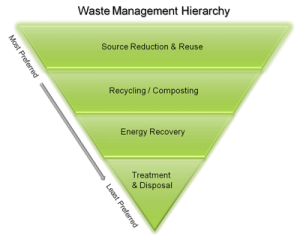 We often focus on recycling as it feels like such a direct way to help curb the waste stream, yet it’s actually at the bottom of the Reduce, Reuse, Recycle hierarchy.
We often focus on recycling as it feels like such a direct way to help curb the waste stream, yet it’s actually at the bottom of the Reduce, Reuse, Recycle hierarchy.
If you want to save energy, water and resources, the best thing you can do is reduce the items you consume (products, packaging) and then reuse the items as many times as possible.
Ideas for reducing plastic waste:
Some of them seem obvious but do you actually do them? Could you do a few more? It might be easier than you think.
Compare brands to look for alternatives: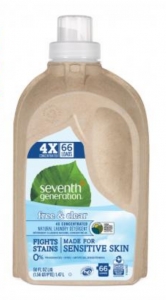
If you are considering buying a product but it comes packaged in plastic, see if there’s another brand that doesn’t. Rice or pasta often comes with the choices of plastic bags or cardboard. Cardboard is at least recyclable or compostable. Some products these days are being purposefully designed to create less waste – Seventh Generation has a laundry detergent designed to reduce waste – the detergent is concentrated to provide 4X the number of loads, and the package is a thin plastic bag enclosed in a clever sturdy recyclable/compostable cardboard shell. It’s also lighter to transport so uses fewer fossil fuels than heavier containers. Keep your eyes open for options like these.

Buy in Bulk: Better yet, look for stores that have bulk bins – you can bring a reusable container and buy your rice or pasta (or granola, or nuts, or flour, etc) in bulk. It saves you money as well! Some places even have bulk shampoos, olive oil, peanut butter, etc.
Make a bigger impact by creating a demand: Contact the company you passed over with a quick email telling them that you chose another brand due to the amount of plastic the company used to package their product.
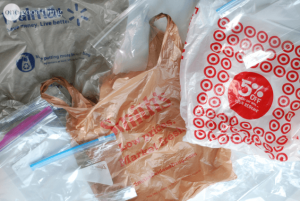 Reuse Plastic Bags:
Reuse Plastic Bags:
Many plastic bags can be reused instead of automatically thrown away. Bigger plastic bags might save you money if they fit in your kitchen trash can instead of using a new trash bag. Produce bags and the bags that once held items like tortillas are a good size to replace the use of a new ziplock bag. Click the photo for 60+ more ways to reuse plastic bags!
Shopping bags of course are a major source of plastic waste and 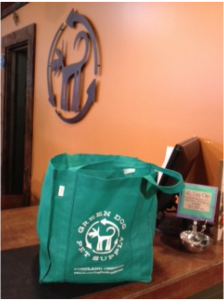 are especially dangerous to our oceans and waterways, so getting into the habit of bringing your own shopping bags can significantly reduce the amount of plastic you use. In Portland, we have banned the use of plastic bags, so we’ve gotten pretty used to bringing our own, though many people still rely on paper shopping bags. Try hanging reusable bags on your doorknob, so that the next time you go out to the car you can bring them with you.
are especially dangerous to our oceans and waterways, so getting into the habit of bringing your own shopping bags can significantly reduce the amount of plastic you use. In Portland, we have banned the use of plastic bags, so we’ve gotten pretty used to bringing our own, though many people still rely on paper shopping bags. Try hanging reusable bags on your doorknob, so that the next time you go out to the car you can bring them with you.
Make a Bigger impact: Call or write your local representatives and tell them you want plastic bags banned in your city. Volunteer with others to get it on your next ballot.
Stop buying bottled water if you can:
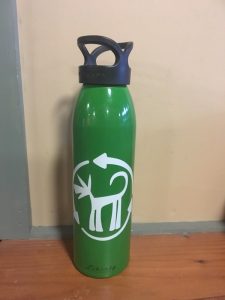 You’re paying a huge amount of money for something that may or may not be as good for you as your tap water (and up to 40% of bottled water is simply tap water, bottled). If you’re worried about quality, you can buy a great faucet filter for not much money- if you add up what you’re paying per gallon of bottled water in a year ($1-$2 per bottle, vs. .0015 cents per gallon of tap water), you might be surprised at the total – what else could you have purchased with that money? Though plastic bottles can be recycled, only about 10% off bottles are and this process also uses a great deal of energy. More here
You’re paying a huge amount of money for something that may or may not be as good for you as your tap water (and up to 40% of bottled water is simply tap water, bottled). If you’re worried about quality, you can buy a great faucet filter for not much money- if you add up what you’re paying per gallon of bottled water in a year ($1-$2 per bottle, vs. .0015 cents per gallon of tap water), you might be surprised at the total – what else could you have purchased with that money? Though plastic bottles can be recycled, only about 10% off bottles are and this process also uses a great deal of energy. More here
Bring your own coffee travel mug:
Disposable coffee cups might look like paper but they’re usually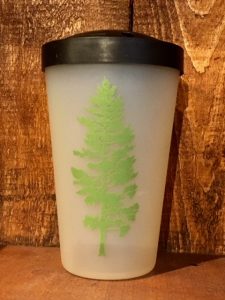 lined with polyethylene, a type of plastic resin. In theory these materials can be recycled, but most places lack the infrastructure to do so. Each to go cup comes with plastic lids, and perhaps stirrers, and when I travel I’m always surprised at the number of places that still use styrofoam cups.
lined with polyethylene, a type of plastic resin. In theory these materials can be recycled, but most places lack the infrastructure to do so. Each to go cup comes with plastic lids, and perhaps stirrers, and when I travel I’m always surprised at the number of places that still use styrofoam cups.
Avoid frozen foods:
Many are packaged with non recyclable plastic trays and the boxes are lined with plastic resin and cannot be recycled.
Skip the straws
Get the plastics off your face: – treehugger.com rightly points out that “Much of the plastic that’s polluting the oceans is microplastics, tiny chunks that are next to impossible to filter out. These plastics can come from bigger items breaking down, but they are also commonly added to consumer products like face wash and toothpaste. These little beads are intended to be exfoliators, but many wastewater treatment facilities aren’t able to stop them. There are many biodegradable alternatives, so avoid items with “polypropylene” or “polyethylene” on the ingredients list or consider making your own.”
Women: consider how to make your period waste free:
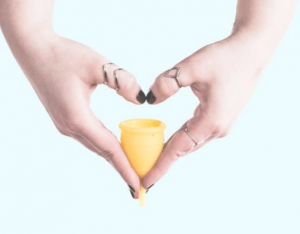 There are lots of options out there for reusable period products ranging from Lunette Cups/Diva cups (these seem odd or maybe even terrifying to some at first, but they are actually comfortable and super easy to use and to clean, and a fantastic way to reduce or eliminate pads and tampons) to products like sea sponge tampons and reusable Luna pads
There are lots of options out there for reusable period products ranging from Lunette Cups/Diva cups (these seem odd or maybe even terrifying to some at first, but they are actually comfortable and super easy to use and to clean, and a fantastic way to reduce or eliminate pads and tampons) to products like sea sponge tampons and reusable Luna pads
Smaller steps are still great: find plastic-free organic pads and tampons from companies like Seventh Generation, Rael or Veeda
If nothing else, please consider skipping tampons with plastic applicators – there are nicer cardboard ones these days with rounded tips, and tampons that come without an applicator as well. It’s really not that bad and saves so many resources.
Reduce or eliminate the number of disposable diapers you use for babies:
One mother gives these great reasons: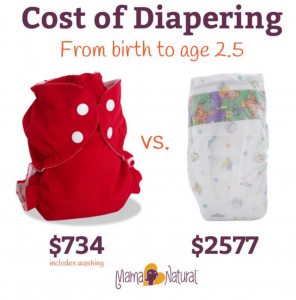
1) My children got more rashes with disposables than with cloth. (we use disposables on trips when laundry services aren’t easily accessible)
2) My children got more leaks and blowouts with disposables than with cloth. Not even close.
3) Laundering is more work with cloth, agreed. (but less work than it would take to make the money to pay for the more expensive disposable option… and less harm to the environment, etc)
4) Wet bags take care of the smell (air-tight zipped-up bag) A room smells much worse when it’s got a trashcan full of disposables than when we have the cloth diapers in their bag.
6) The initial price for cloth is more, but the ongoing price is less – a TON less. (that price given in the photo above includes washing). Unless you have a ton of kids, there is no replacement cost with cloth. (ours have made it through 3 kids). And they’re often cuter than disposable! Click the photo to learn more about reusable diapers.
Food storage:
At home, use mason jars or other reusable containers in the fridge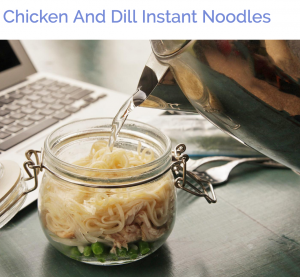 instead of sandwich bags. Mason jars are a great way to transport your lunch to work – many people use them for salads with dressing in the bottom so they can shake it all up later, but there are so many more ideas out there (Click the photo for other mason jar meal ideas) If you do bring home a plastic deli container full of olives or potato salad, wash it and treat it like a Tupperware – bring food to work in it, or use it again at the deli for more olives.
instead of sandwich bags. Mason jars are a great way to transport your lunch to work – many people use them for salads with dressing in the bottom so they can shake it all up later, but there are so many more ideas out there (Click the photo for other mason jar meal ideas) If you do bring home a plastic deli container full of olives or potato salad, wash it and treat it like a Tupperware – bring food to work in it, or use it again at the deli for more olives.
Takeout Containers: You could even try bringing reusable containers to your favorite carry out restaurants – find one that’s about the same size as the one they normally give you and see if they’re willing to use it. Can you skip the plastic utensils?
Being a responsible consumer is easy – simply starting to consider where things come from that you buy, and where they might go when you’re done with them is the foundation of sustainable living. Incorporate small changes into your daily routine at first until they become a habit. Then think of a few news ones to tackle!


Nice blog, the Ideas for reducing plastic waste i am gonna try them all, after all, we are only responsible for damaging our environment. So, start to Reduce, Reuse and Recycle.